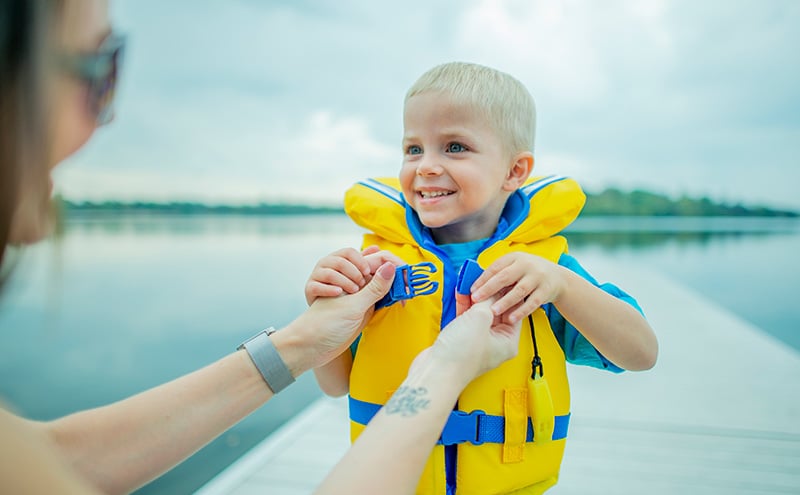
Drowning is the Single Leading Cause of Death Among Children Aged 1-4 Years and a Top Cause of Death Among Teens
Maryuri Cannon, MD, University of Florida and Wolfson Children’s Hospital, Jacksonville, FL
Cristina Zeretzke-Bien, MD, University of Florida and Wolfson Children's Hospital, Jacksonville, FL
Drowning prevention requires a multifaceted approach that includes supervision, physical barriers, swimming skills, and policy measures. Addressing drowning from different angles and being prepared as a parent and family member will help to decrease the number of preventable accidents this spring and summer.
Supervision
Supervision is critical, especially for toddlers who are the children at higher risk. Effective supervision should be put into practice by focusing on three main points: attention, proximity and continuity. In very young children, “touch” or arm’s length supervision is recommended. Do not get distracted with other activities, such as reading, playing, games, using the cell phone, or mowing the lawn. Supervision implies having a dedicated parent to watch the kids while they are in the water. Especially during reunions, picnics at the pool or lake when it is easy to get distracted, assign a “water watcher” whose role is to keep eyes on the kids. Take turns by passing a swimming card, or swimming jacket, to another adult after a predetermined time.
Physical Barriers
Physical barriers, such as four-sided fencing around residential pools, including large inflatable above-ground pools and other temporary pools, have been shown to reduce toddlers drowning by 83% in other countries like Australia. Pool fences should be at least 4 feet high and have no opening under it or between slats more than 4 inches wide to separate the pool from the house. Have a self-closing and self-latching gate that opens away from the pool, with the latch at least 54 inches from the ground. Keep toys out of the pool area when not in use so that children are not tempted to try to get through the fence during non-swim time. Empty water containers immediately after use, never leave a filled open-top water container unattended.
Water Safety in the Bathroom
Bath time should be fun and not add additional stressors to your family routine. Use touch supervision, have everything ready with a towel and other bath supplies within reach so you can always keep a hand on your baby. Most drowning accidents happen at bath time, and more than half of bathtub deaths involve children under 1 year of age. These accidents frequently happen during a lapse in adult supervision. Beyond bath time, protect your baby from other water hazards in the bathroom. Babies can topple headfirst into the toilet bowl and are incapable of getting themselves out, put toilet lids down and keep the bathroom door closed.
Swimming Training Competency
Swimming training competency is another preventive measure. When to start? Keep in mind your child’s emotional maturity, physical strength, and developmental abilities and limitations. Studies have suggested water survival skills training and swim lessons can reduce drowning risk for children aged 1–4 years. The American Academy of Pediatrics (AAP) recommends swim lessons as a layer of protection against drowning that can begin for children as early as age 1 year. Classes that include parents are especially beneficial because they help to introduce good water safety habits. By their fourth birthday, most children are ready for swim lessons. At this age, children can learn floating, treading water, and getting to an exit point. By age 5–6 years, most children can master the front crawl. Teach basic swimming skills, along with caregiver education about the importance of vigilance, without forgetting that swim lessons do not make kids “drown proof.”
Learn Cardiopulmonary Resuscitation
Parents and caregivers should know cardiopulmonary resuscitation (CPR) and how to get emergency help. CPR class can be found at the American Red Cross, The American Heart Association, and local fire departments, as well as other organizations.
Always use life jackets when in, on, or near natural bodies of water, such as lakes and rivers. Also, make sure the life jackets fit properly and are approved by the U.S. Coast Guard.
Hope this helps make your water activities more enjoyable and introduces good water safety tips to prevent drowning. Drowning can be prevented if you implement good supervision, place physical barriers from danger, water safety in the bathroom, teach basic swimming skills, and learn CPR. Keep safe and enjoy your time with all the water activities.
References
- Girasek DC, Hargarten S. Prevention of and Emergency Response to Drowning. N Engl J Med. 2022;387(14):1303-1308. doi:10.1056/NEJMra2202392
- Franklin RC, Peden AE. Improving Pool Fencing Legislation in Queensland, Australia: Attitudes and Impact on Child Drowning Fatalities. Int J Environ Res Public Health. 2017;14(12):1450. Published 2017 Nov 24. doi:10.3390/ijerph14121450
- Thompson DC, Rivara FP. Pool fencing for preventing drowning in children. Cochrane Database Syst Rev. 2000;1998(2):CD001047. doi:10.1002/14651858.CD001047Brenner RA. Prevention of drowning in infants, children, and adolescents. Pediatrics. 2003;112(2):440-445. doi:10.1542/peds.112.2.440
- Drowning Prevention Campaign Toolkit - American Academy of Pediatrics. https://www.aap.org/en/news-room/campaigns-and-toolkits/drowning-prevention/. Accessed May 5, 2025.




